 Pirates and Privateers Pirates and Privateers
The History of Maritime
Piracy
Cindy Vallar, Editor
& Reviewer
P.O. Box 425,
Keller, TX 76244-0425
    
Books for Adults ~ History: Navy
(United Kingdom)
Ships & Sailing
Anson's Navy
Nelson's Victory
Royal Tars
Wooden Warship
Construction
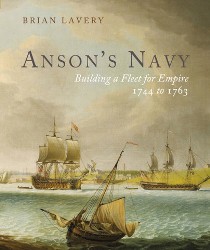
Anson’s Navy: Building a
Fleet for Empire 1744-1763
by Brian Lavery
Seaforth, 2021, ISBN 978-1-3990-0288-2, US $52.75 / UK
£40.00
review by Irwin Bryan
    
Brian
Lavery has written many books about the early
defenders of the British realm at sea and the Royal
Navy. As a former senior curator at Greenwich’s
National Maritime Museum, he is an acknowledged
expert on the navy’s wooden world. In this book, he
takes a fresh look at Admiral Lord George Anson’s
career and his impact on improvements to the Royal
Navy before and during the Seven Years' War.
Anson led a 1740 expedition to the Pacific Ocean to
capture a rich Manila galleon and its Spanish gold.
He then completed a circumnavigation like Francis
Drake had done when he also captured one of the
galleons. Although Anson’s Centurion was
the only ship to return in 1744, the others having
turned back, wrecked, or ruined, the voyage was
considered a great success with thirty-two wagons
full of treasure brought to the Tower of London at a
time when England needed a victory. This despite the
loss of over 1,000 mariners to scurvy and other
maladies. Unfortunately, this was a regular
occurrence on long voyages in that era.
Anson’s seniority, success, and wealth made him the
right choice to join the Board of Admiralty. At a
time when corruption, fraud, and waste were rife
among the navy’s vendors and shipyards, and senior
officers’ applications of privilege were damaging
the development of the officer corps, someone was
needed who knew what the problems were and would be
unaffected by offers of graft and
influence-peddling. Anson was
the right pick for the job.
This book presents the navy’s need for
changes and the positive improvements that were made
in thirteen chapters. These cover all aspects of
naval service and administration. Each chapter
focuses on different areas of concern, such as the
ships, officers, crews, and shipboard life. Other
chapters discuss the fleets, strategy and tactics,
amphibious warfare, and more. This is a lavish,
oversized book printed on glossy paper with many
contemporary paintings and illustrations throughout
the text. A section of notes is followed by a
considerable bibliography and index.
There is a lot of information in this book, but it
is related in a clear manner without technical
jargon, or the drone of facts found in textbooks.
Despite my lack of familiarity with the Royal Navy
in this time period, I feel fully informed now and
understand how much better the navy is prepared at
the start of the Seven Years' War.
It is a surprise to learn that Anson serves at sea
again after his time at the Admiralty. If you want
to read about the Age of Sail or something other
than the French Revolution and Napoleonic Wars, this
is an excellent guide on the mid-18th-century state
of the Royal Navy, even for a novice on England’s
wooden walls!
Review
Copyright ©2022 Irwin Bryan

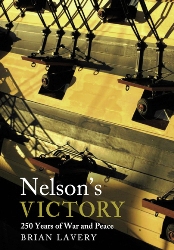
Nelson’s Victory: 250 Years of War and
Peace
by Brian Lavery
Seaforth, 2015, ISBN 978-1-84832-232-5, $56.95 /
£30.00
Also available in other formats
    
She
is a national and
international icon with
special place in the
affection of the British
people . . . HMS Victory
represents the
embodiment of British
Naval mastery at its
absolute height, when
Britain’s supremacy over
all of her actual or
potential enemies was
unchallenged and the
Royal Navy enjoyed
supreme command of the
world’s oceans . . . (200)
These words of the
National Register of Historic
Vessels explain the importance
of perhaps the most iconic and
extant wooden ship from the Age
of Sail. The orders to build her
are given in 1758, the same year
in which Horatio Nelson is born.
Their careers and the legends
they’ve become parallel each
other, which is one reason
Lavery’s examination of Victory
and the admiral are welcome
additions to maritime history.
It is also a fitting celebration
during her bicentennial.
Both Admiral Nelson and what
will become his flagship begin
their naval careers in Chatham,
and the early chapters discuss
this historic dockyard, the
building of Victory and
the developments that lead to
her being the most advanced
warship of her time, and
Nelson’s early years both before
and after he joins the Royal
Navy. Prince William Henry will
describe him as “the merest boy
of a captain that I ever
beheld,” while Rear-Admiral Lord
Samuel Hood says of him:
There was
something irresistibly
pleasing in his address and
conversation; and an
enthusiasm, when speaking on
professional subjects, that
showed he was no common
being. (50)
Lavery also looks
at Victory’s voyages and
battles as well as what her life
is like following Nelson’s death
at Trafalgar. Both of their
lives have high points and low
points, which are portrayed not
only through the author’s
narrative but also from the
perspectives of those who sail
aboard the ship. In her later
years, visitors, such as Queen
Victoria and Beatrix Potter,
also record their impressions of
her.
What makes Nelson’s Victory
a valuable resource is that it
is one of the few books
examining her entire life in the
water, from birth to present
day. Most volumes focus on a
specific period during those 250
years, such as when she is
Nelson’s flagship or how events
unfold at the Battle of
Trafalgar. Lavery, instead,
discusses her life as a warship,
a hospital ship, a venue to
entertain or to hold a
court-martial, a training ship,
and a living museum. Efforts to
preserve and protect her are
also included. A bibliography,
endnotes, and index complete the
book.
As guest curator of the recent
exhibition HMS Victory:
The Untold Story at The
Historic Dockyard Chatham and
someone who has served for more
than two decades on Victory’s
advisory board, Lavery has a
firm grasp of both who this ship
was and the legendary and
national symbol she has become.
The many wonderful illustrations
– portraits, artwork, maps,
diagrams, and photographs – make
Victory and Admiral
Nelson real, while the primary
quotations supplement and enrich
the reader’s understanding of
who they were/are and why they
are important then and now. Even
those who have read multiple
illustrated works on these
topics will delight in rare
gems, such as the sketch showing
the faces and names of some of Victory’s
crew during Nelson’s command or
the photograph of the full-scale
model of the warship built for
the Royal Navy Exhibition in
1891 in Chelsea. This oversized,
full-color treatise is well
worth the cost and is a fitting
memorial to the ship, her most
famous admiral, and those who
have worked on her or sailed
aboard her.
Review
Copyright ©2015 Cindy Vallar

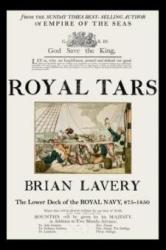
Royal Tars: The Lower Deck of
the Royal Navy, 875-1850
by Brian Lavery
Naval Institute Press, 2010, ISBN
978-1-59114-743-5, US $37.95
    
When Brian Lavery
set out to write about the men
who manned the lower deck of
British warships, he expected
to tell their whole story. The
more he delved into the
factors influencing how these
essential seamen evolved, the
more he realized he could not
do so in a single volume that
included the past all the way
to the present.
This first
volume discusses this aspect
of naval history from the
first record of England
establishing a navy under
King Alfred through the
first steam warships and the
establishment of training
schools for seamen. He
divides the material into
seven periods:
- The Early
Seaman, before 1642
- Civil War
and Dutch Wars, 1642 to
1689
- European
War, 1689 to 1739
- Imperial
War, 1739 to 1783
- The Crisis,
1783 to 1803
- A Large
Fleet in a Long War,
1803 to 1815
- The Long
Peace, 1815 to 1850
Within each
chapter, he explores the
average seaman’s character,
skills, daily routine, and
his attitudes toward those
he serves under and the
regulations that affect his
life. Lavery demonstrates
how these men also change
history’s course on
occasion, and uses their
firsthand accounts, where
available, of the battles in
which they fight. In
addition to the introduction
and conclusion, the book
includes an appendix
(Tracing Naval Ratings),
glossary, notes,
bibliography, and index.
Where appropriate the reader
will find maps and diagrams
that illustrate various
aspects of the material.
There are also several
sections of drawings and
paintings to further enhance
the content.
Lavery has
produced a readable and
compelling account of these
men who are often
overlooked, but are
essential to the Royal Navy.
The narrative clearly shows
the wealth of primary
documents and exhaustive
research he did to track
down this information. Royal
Tars not only shows
how the lower deck, which
did not initially exist,
develops but also dispels
the stereotypical
description commonly
associated with seamen.
Review
Copyright ©2011 Cindy Vallar

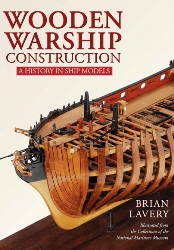
Wooden Warship
Construction
by Brian Lavery
Seaforth, 2017, ISBN 978-1-4738-9480-8,
US $34.95 / UK £25.00
review by Irwin Bryan
    
This
latest addition to
Seaforth’s A History
in Ship Models
series is a
wonderful book
detailing the
construction of the
Royal Navy’s sailing
warships. Lavery
uses his intimate
knowledge of the
models on display at
the National
Maritime Museum in
Greenwich, England
to perfectly marry
the text with the
pictures. These
visual
representations
often have added
graphics to identify
each part mentioned.
The publication
begins with a
description of
shipyards in the
18th century. The
layout and specific
sites at the
facility are
explained using
models of a private
yard at Buckler’s
Hard at Hampshire,
England and the
Royal Dockyards at
Chatham and
Deptford. (11,
16-17) These models
are referenced
repeatedly to
illustrate what is
being discussed. The
roles of the
shipwrights who do
the majority of the
work assembling the
ship are explained.
Lavery also presents
information on the
different parts of
trees used and how
timber is stored.
Several pages of
models serve to
illustrate the
different types of
ships these yards
build. Like every
other color image, a
detailed caption
describes each
picture and begins
with their
collection catalogue
number. Additional
information on any
model or picture
shown can be
obtained by going to
the museum’s
collections website
and entering the
corresponding
reference number in
the search box.
After the stage is
set, all of the
remaining chapters
follow the sequence
in which a ship is
built. Each vessel
ordered begins with
a draught, or plan
which “also included
much detail of the
dimensions of
individual
parts.”(36) Each
draught has a ratio
of 1:48, or one inch
to four feet.
Beginning in 1715,
the master
shipwrights of the
Royal Dockyards are
required to produce
models that include
the galleries, all
ports, deck heights,
and many other
features. This is
named as “the
starting point of
this book.”(40)
These improved
models need to show
the hull’s
waterline, true
dimensions and
shape. The draughts
of any ordered
vessels are sent to
the shipyard’s Mould
Loft where full-size
plans of the various
parts are drawn on
paper covering the
floor. These serve
as guides for the
sawing of timber.
Once a slip is
chosen and prepared,
the actual building
of a vessel can
begin. Ships are
made “from the
bottom up,” which is
probably the origin
of that common
phrase. The keel is
the first part
assembled and
carefully positioned
in the slip. Some of
the highlights that
follow include
illustrations of the
sternpost and bow
structure (50-51), a
model showing the
interior of a
seven-frame section
with three gun ports
(55), another “of a
74-gun ship showing
different stages in
the framing and
planking” (68-69),
and “a midship
section . . .
showing many details
of construction.”
(74) A variety of
diagrams and models
show the complex
structure inside the
hull made to support
the weight of the
decks and guns.
Other photographs
show different
phases of decks and
planking being
built. Some of the
required fittings
are also provided,
including anchors,
capstans, the
double-helm, and
galley stove.
Due to signs of
decay in ships
recently built or
repaired, some
design changes are
introduced at this
time. A method of
strengthening the
bow and stern is
developed which
calls for the use of
canted timbers afore
and abaft the bow
and stern posts.
Changing the sides
from double wales to
single wales with
narrower strakes
behind them and
better fill between
them is expected to
“make a fair side.”
(41)
The appendix divides
any vessel’s
construction into
twenty-five parts
and shows what the
shipwrights will
earn for the
completion of each
part (based on the
different rates
(types) of ships
built). Suggested
readings are found
on the last page.
Information on the
other two books in
the series – The
Sailing Frigate
by Robert Gardiner
and The Ship of
the Line by
Lavery – can be
found on the inside
back flap of the
book jacket.
Although there is no
index, the subject
matter progresses
from gathering the
labor and materials
to having the new
ship afloat.
From the framing
until the launching
only sixty pages
remain. In a book so
copiously
illustrated, the
reader expects only
a brief overview of
the parts and
processes that
follow. Incredibly,
so many details are
presented you can’t
possibly remember
them all after one
reading. Anyone
considering building
an authentic wooden
ship model or
researching any
aspect of ship
construction will do
well to begin with
this excellent book.
This is also a
reference that
writers and readers
of fiction can
consult time and
again whenever their
hero’s ship sustains
damage.
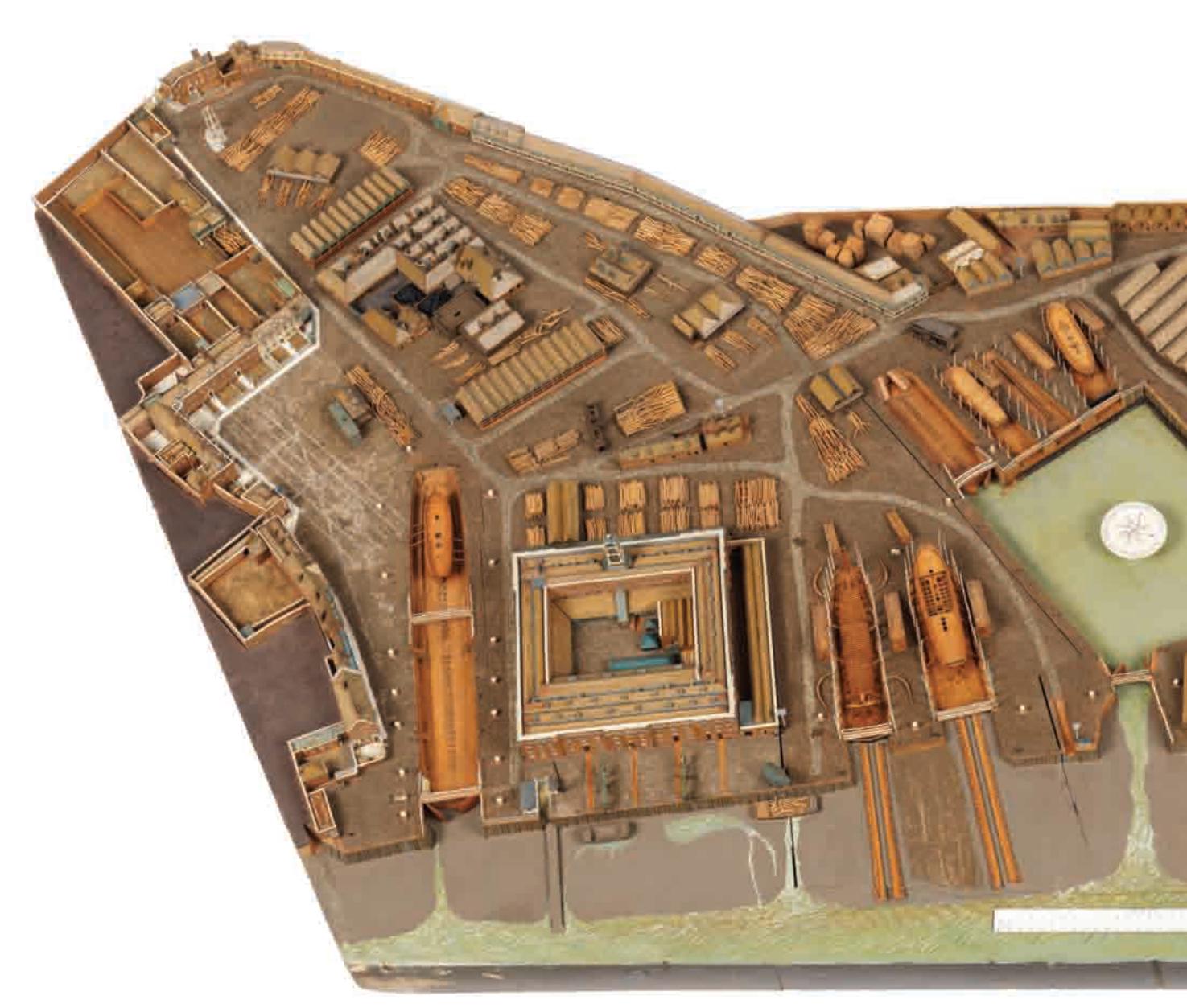 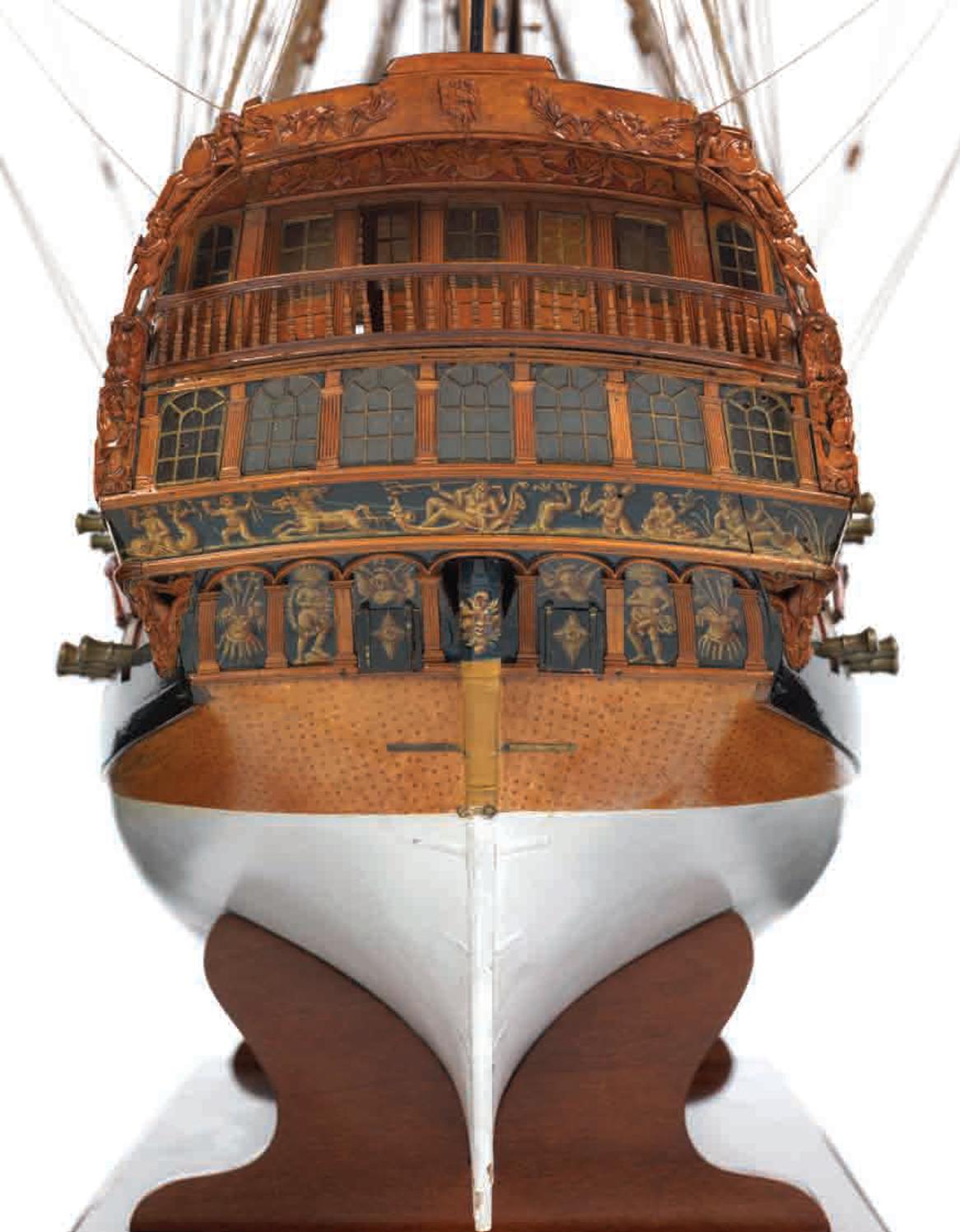
Sample
illustrations
from Wooden
Warship
Construction.
Left:
Deptford
Dockyard
(SLR2906) in
1772-1774.
Left side:
shows
Officers'
houses and
gardens,
Offices, and
Master
shipwright's
house. Bottom:
Double dry
dock, Grand
Storehouse,
Barges, Ship
with floors
crossed, and
Ship being
planked. Top:
Dockyard gate,
Smithery,
Workshops, Dry
dock, and
Building
slips.
Right:
Model of Centurion's
Stern
(SLR0442).
Shows
Taffrail,
Cove, Stern
Windows,
Gallery rail,
Upper counter,
Lower counter,
Trenails
planking,
Frieze, and
Quarter pieces
(Source:
Seaforth
Publishing, used
with permission,
images
copyrighted)
Review
Copyright ©2017 Irwin
Bryan


Click to contact me
Background image compliments
of Anke's Graphics |






